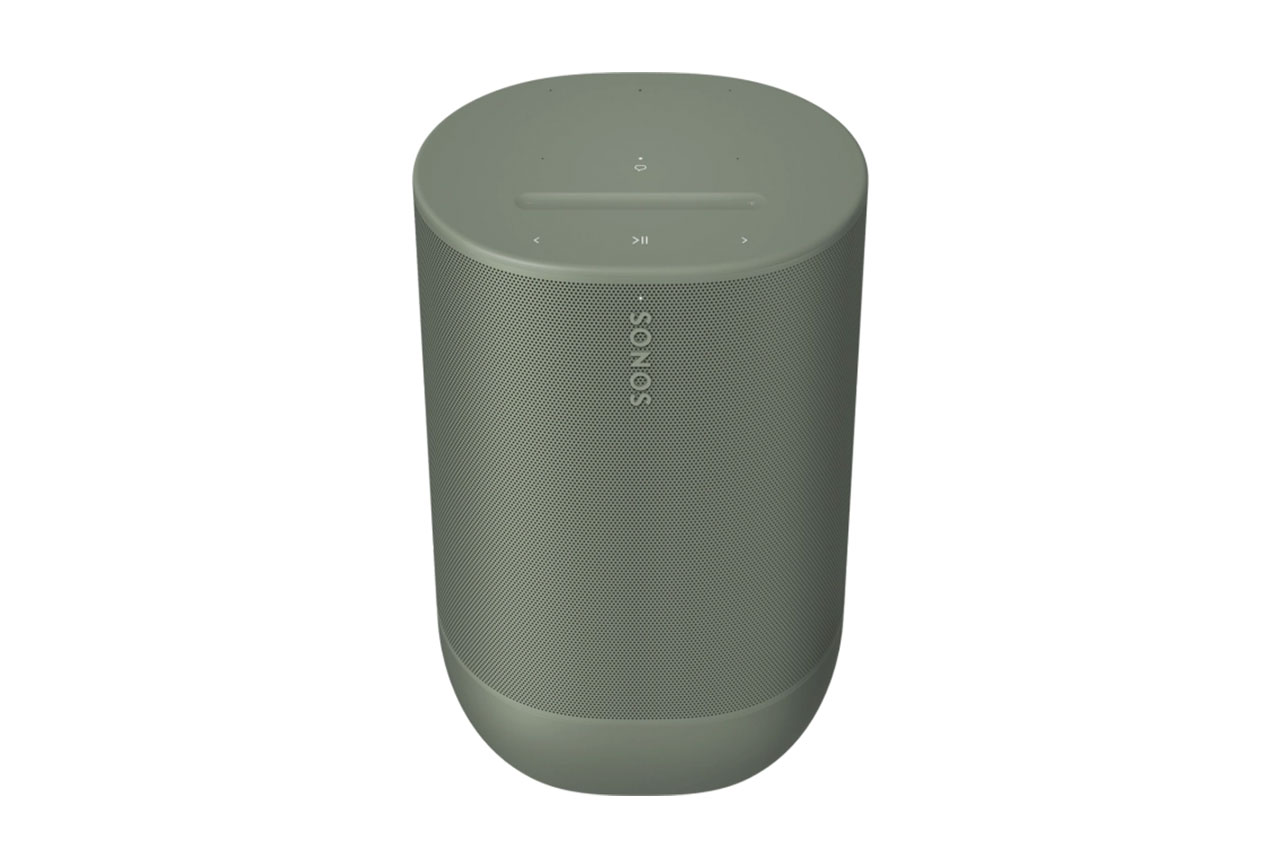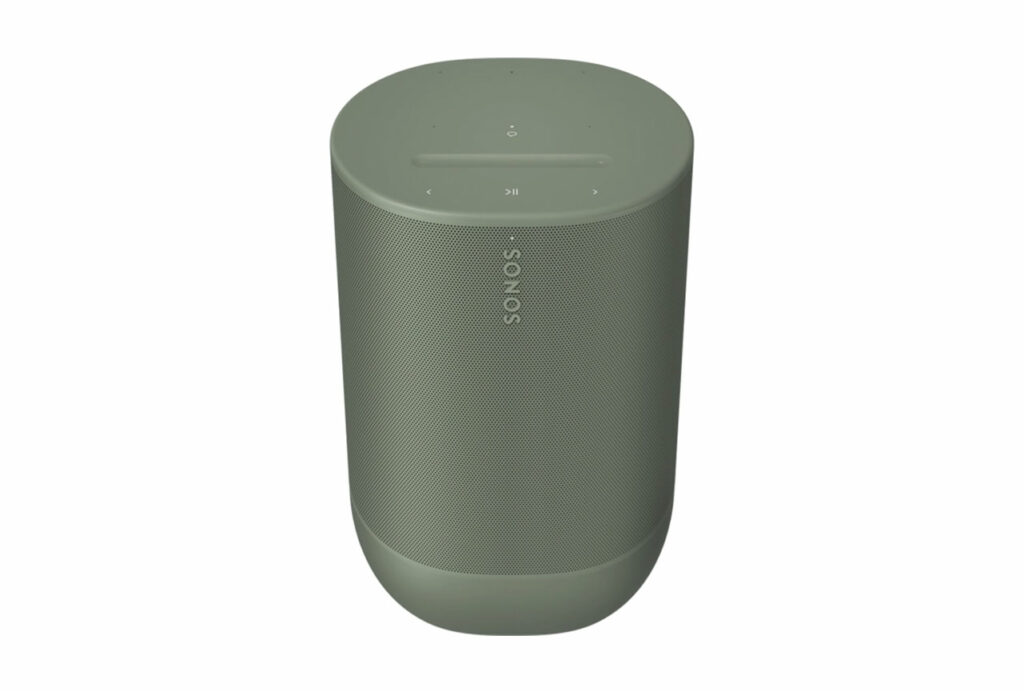We put the Sonos Move 2 through our rigorous DXOMARK Audio test suite to measure its performance at playing back audio. In this review, we will break down how it fared in a variety of tests and several common use cases.
Overview
Key specifications include:
- Wireless protocols: AirPlay
- Wired connectivity: USB-C
- Height: 24.1 cm. Width: 16.0 cm. Depth: 12.7 cm
- Weight: 3000.0 g
Test conditions:
- Tested with iPhone SE
- Communication protocol used: AirPlay
 Sonos Move 2
Sonos Move 2


Pros
- Pleasant and natural timbre
- Mostly free of artifacts
- Consistent performance across different volumes
Cons
- Treble can sound dull or dark
- Stereophony is negligible
- Lack of punch
The Sonos Move 2 is a portable speaker that as its name suggests is meant to be on the move, whether indoors or outdoors.
Its best performance in our tests was in the outdoor use case, playing music. But the speaker’s playback scored well in both our relaxing use case as well as the party use case, at both low and high volumes, attesting to its versatility.
While Sonos says that it redesigned the Move 2 by replacing the previous single tweeter with two for a higher-fidelity stereo soundstage, our testing showed that wideness was strongly limited in all use cases.
But overall, the Sonos Move 2’s audio performance should be satisfying for most types of situations.
Listen to the tested speaker’s playback performance in this comparison with its competitors:
Test summary
About DXOMARK Wireless Speaker tests: For scoring and analysis in our wireless speaker reviews, DXOMARK engineers perform a variety of objective tests and undertake more than 20 hours of perceptual evaluation under controlled lab conditions. This article highlights the most important results of our testing. Note that we evaluate playback using only the device’s built-in hardware. (For more details about our Speaker protocol, click here.)
The following section gathers key elements of our exhaustive tests and analyses performed in DXOMARK laboratories. Detailed performance evaluations under the form of reports are available upon request. Do not hesitate to contact us.
The DXOMARK Speaker overall score is derived from a range of sub-scores. In this section, we will take a closer look at timbre, dynamics, spatial, volume, and artifacts, and explain what they mean for the user.

Timbre
Sonos Move 2
152
DXOMARK timbre tests measure how well a speaker reproduces sound across the audible tonal range and takes into account bass, midrange, treble, tonal balance, and volume dependency.
The Move 2 offered a pleasant timbre that sounded natural and warm. Tonal balance was consistent across use cases, even at maximum volume, but it lacked brilliance and high-end extension when compared to other devices. As a result, it could sound a bit dull or dark. The midrange was quite satisfying and warm, although it could sound slightly muddy in some cases, for instance in the party use case and on podcasts. Bass was pretty good regardless of the use case, and even though it could lack a bit of low-end extension and depth, it sounded powerful overall; actually a bit too much for reverberant acoustics such as in the bathroom use case. Aside from that, the performance was really satisfying for the speaker.
The main drawback in terms of timbre stemmed from the previously mentioned lack of high-end extension, and generally an upper treble region that could sound a bit dull. Even though objective measurements showed a very linear treble, the listener’s experience was slightly impaired by the lack of brightness. Tonal balance was overall pretty consistent around the device, despite a loss of brightness from the back of the speaker.

Dynamics
Sonos Move 2
137
Our dynamics tests measure how well a device reproduces the energy level of a sound source, taking into account attack, bass precision, and punch.
The dynamic envelope was quite accurate. In the low-end, bass stayed realistic in most use cases, although it sounded a bit blurry in the bathroom use case. Attack was satisfying regardless of volume, staying decently sharp both at a quiet level such as in the bedroom use case, or at high volume in the party use case. However, it could still sound snappier. The Move 2 was slightly less performant in terms of punch, sounding a little too flat or muddy in some cases. No compression was observed during the tests.

Spatial
Sonos Move 2
111
Our spatial tests measure a speaker’s ability to reproduce stereo sound in all directions, taking into account localizability, balance, wideness, distance, and directivity. Please note that wideness is 0 on mono speakers and on speakers that cannot deliver a significant stereo effect.
The speaker’s spatial performance was average. The device is stereophonic, but wideness was strongly limited in all use cases. Conversely, it wasn’t omnidirectional enough to offset the lack of wideness. Localizability was decent in most use cases, although the precise position of some elements in the mix was sometimes a bit blurry, mostly due to the narrow image. Distance rendition was generally correct. However, content could be perceived to be a bit too far sometimes.

Volume
Sonos Move 2
141
Our volume tests measure both the maximum loudness a speaker is able to produce and how smoothly volume increases and decreases based on user input.
Volume steps distribution was very consistent and smooth, resulting in an overall good performance. Loudness at max volume, however, was a bit below expectations, even though the overall performance at maximum volume was very consistent.
Here are a few sound pressure levels (SPL) we measured when playing our sample recordings of hip-hop and classical music at maximum volume:
| Correlated Pink Noise | Uncorrelated Pink Noise | Hip-Hop | Classical | Latin | Asian Pop | |
| Sonos Move 2 | 89.1 dBA | 86.8 dBA | 82.9 dBA | 79.6 dBA | 85.2 dBA | 78.2 dBA |
| Klipsch The Three II | 93.2 dBA | 92.7 dBA | 91.1 dBA | 85 dBA | 92.3 dBA | 86.1 dBA |
| Astell&Kern ACRO BE100 | 86.3 dBA | 83.4 dBA | 83.8 dBA | 75.6 dBA | 85.7 dBA | 77.3 dBA |

Artifacts
Sonos Move 2
133
Our artifacts tests measure how much source audio is distorted when played back, along with such other sound artifacts as noise, pumping effects, and clipping. Distortion and other artifacts can occur both because of sound processing and because of the quality of the speakers.
Perceptually, very few artifacts were present during the evaluation, and performance was excellent. But there was some slight distortion as well as compression at maximum volume. The compression came in the form of subtle overshoots, which did not really affect the auditory experience. Objective measurements also showed some excellent results in the artifacts attribute.


